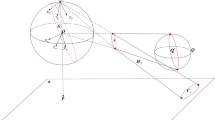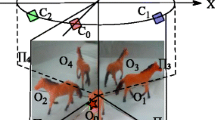Abstract
This paper deals with the calibration of a cylindric omnidirectional imaging system, based on a rotating 2,048 pixels linear camera which provides high definition panoramas. The two-step algorithm relies on line-segment projections as calibration features, which are sinusoidal curves. We proposed a cylindrical line detection, based on the dual principle of the Hough transform. Moreover, the use of Plucker coordinates introduces some new characteristics in the calibration process. This kind of formalism allow a linearization of the cylindrical projection, which is non-linear in the usual way. Results obtained from this first step are used to evaluate one of the intrinsics, the other one being determined by a linear criterion minimization in the dual space, i.e. the sines magnitudes space.
Similar content being viewed by others
References
Baker S., Nayar S. (1999) A theory of single-viewpoint catadioptric image formation. Int. J. Comput. Visi. 32, 175–196
Benosman, R. Reconstruction d’environnements pertus par un capteur panoramique de stéréovision et détermination des modèles CAO. PhD thesis, Université Pierre et Marie Curie (1997)
Benosman R., Kang S.B. (2001) Panoramic Vision: Theory, Sensors and Applications. Springer, Berlin Heidelberg New York
Benosman R., Manière T., Devars J. (1996) Multi-directionnal stereovision sensor, calibration and scenes reconstruction. 13th Int. Conf. Pattern Recognit. A, 161–165
Benosman R., Manière T., Devars J. (1997) Panoramic sensor calibration using computational projective geometry. IEEE Int. Conf. Rob. Autom. 2, 1353–1358
Bunschoten, R., Krse, R. Range estimation from a pair of omnidirectional images. In: Proceedings of IEEE International Conference on Robotics and Automation, pp. 1174–1179 (2001)
Cao Z.L., Oh E.L., Hall S.J. (1986) Dynamic omnidirectional vision for mobile robots. J. Rob. Syst. 3(1):5–17
Cauchois, C., Brassart, E., Delahoche, L., Clerentin, A. 3d localization with conical vision. In: Proceedings of IEEE Workshop on Omnidirectional Vision OMNIVIS’03, June 2003
Chang, P., Hebert, M. Omni-directionnal structure from motion. IEEE Workshop on Omnidirectional Vision (OMNIVIS), September 2000
Duda R.O., Hart P.E. (1972) Use of the hogh transform to detect lines and curves in picures. Communi. ACM 15, 11–15
Faugeras O. (1993) Three-Dimensional Computer Vision. MIT Press, Cambridge
Faugeras O., Maybank S. (1990) Motion from point matches: multiplicity of solutions. Int. J. Comput. Vis. 4, 225–246
Gaspar, J., Decco, C., Okamoto, J. Jr, Santos-Victor, J. Constant resolution omnidirectional cameras. In: Proceedings of IEEE Workshop on Omnidirectional Vision Omnivis’ 02, pp. 27–34, June (2002)
Geyer, C., Daniilidis, K. Catadioptric camera calibration. In: Proceedings of ICCV, pp. 398–404, September 1999
Geyer, C., Daniilidis, K. A unifying theory for central panoramic systems and practical applications. In: Proceedings of ECCV, pp. 445–461, 2000
Geyer C., Daniilidis K. (2002) Para-catadioptric calibration. IEEE Trans. Pattern Anal. Mach. Intell. 24, 687–695
Hartley, R. In defence of 8-point algorithm. In: Proceedings 5th International Conference on Computer Vision, pp 1064–1070, 1995
Hartley R.I., Zissermann A. (2000) Multiple View Geometry in Computer Vision. Cambridge University Press, Cambridge
Hicks, R.A., Perline, R.K. Equi-areal catadioptric sensors. In: Proceedings of IEEE Workshop on Omnidirectional Vision Omnivis’ 02, pp. 13–18, June 2002
Horn B.K.P., Weldon E.J. Jr. (1988) Direct methods for recovering motion. Proc. IJCV 2(1): 51–76
Hough, P. V. C. Machine analysis of bubble chamber pictures. International Conference on High Energy Accelerators and Instrumentation (1959)
Huang, F. Epipolar geometry and camera calibration of cylindrical panoramas. PhD thesis, Auckland University (2000)
Huang, R., Wei, S. K., Klette, R. Comparative studies of line-based panoramic camera calibration. IEEE Workshop on Omnidirectional Vision Omnivis’03, June 2003
Ishiguro I., Yamamoto M., Tsuji S. (1992) Omnidirectcional stereo. IEEE Trans. PAMI. 14, 257–262
Longuet-Higgins H. (1981) A computer algorithm for reconstructing a scene from two projections. Nature 293, 133–135
Luong, Q.T., Vieville, T. Canonic representations for the geometry of multiple projective views. Proceeding of ECCV, July 1994
Nayar, S. K. Catadioptric omnidirectional camera. Proceedings of IEEE CVPR, pp. 482–488, June 1997
Olson, C. F. Constrained Hough transforms for curve Comput. Vis. Image Understand. pp. 329–345 (1999)
Peleg S., Ben Ezra M. (1999) Stereo panoramic with a sngle camera. Proc. IEEE CVPR 1, 395–401
Proceedings of the IEEE Workshop on Omnidirectional Vision (OMINIVIS 2000–2005.)
Shoemake, K. Plucker coordinate tutorial. Ray-Tracing News vol 11, July 1998
Shum, H. Y., Kalai, A., Seitz, S. Omnivergent stereo. In: Proceedings of the Seventh International Conference on Computer Vision (ICCV 99), 1999
Shum H.Y., Szeliski R. (1999) Stereo reconstruction from multiperspective cameras. Proc. IEEE ICCV 1, 14–21
Smadja, L., Bigorgne, E., Benosman, R., Devars, J. Génération de cartes de disparité denses a partir d’images panoramiques cylindriques haute définition. Proc. GRETSI, September 2003
Sturm, P. Mixing catadioptric and perspective cameras. In: Proceedings of the IEEE Workshop on Omnidirectional Vision (OMINIVIS’02), 2002
Swaminathan, R., Nayar, S., Grossberg, M. Designing mirrors for catadioptric systems that minimize image errors. IEEE Workshop on Omnidirectional Vision Omnivis04, June 2004
Tarel, J. P., Gagalowicz, A. Calibration a base d’ellipses. Technical report, INRIA Rocquencourt, 2001
Tsai R.Y., Huang T.S. (1994) Uniqueness and estimation of three dimensional motion parameters of rigid objects with curved surfaces. IEEE Trans. PAMI 6, 13–27
Won K.Y., Mendota P.R.S., Cipolla R. (2003) Camera calibration from surfaces of revolution. Trans. PAMI 25(2): 147–161
Yagi, Y., Kawato, S. Panorama scene analysis with conic projection. Proceedings of the IEEE/RSJ International Workshop on Intelligent Robots and Systems90, p 181187, July 1990
Zhang Z. (1998) Determining the epipolar geometry and its uncertainty: A review. Int. J. Comput. Vis. 27(2): 161–198
Author information
Authors and Affiliations
Corresponding author
Rights and permissions
About this article
Cite this article
Smadja, L., Benosman, R. & Devars, J. Hybrid Stereo Configurations Through a Cylindrical Sensor Calibration. Machine Vision and Applications 17, 251–264 (2006). https://doi.org/10.1007/s00138-006-0032-4
Received:
Accepted:
Published:
Issue Date:
DOI: https://doi.org/10.1007/s00138-006-0032-4




